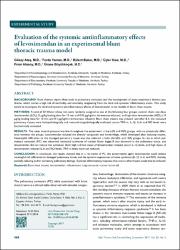| dc.contributor.author | Ateş, Gökay | |
| dc.contributor.author | Yaman, Ferda | |
| dc.contributor.author | Bakar, Bülent | |
| dc.contributor.author | Kısa, Üçler | |
| dc.contributor.author | Büyükkoçak, Ünase | |
| dc.contributor.author | Atasoy, Pınar | |
| dc.date.accessioned | 2021-01-14T18:16:16Z | |
| dc.date.available | 2021-01-14T18:16:16Z | |
| dc.date.issued | 2017 | |
| dc.identifier.citation | Ateş G., Yaman F., Bakar B., Kısa Ü., Büyükkoçak Ü., Atasoy P. (2017). Evaluation of the systemic antiinflammatory effects of levosimendan in an experimental blunt thoracic trauma model. Ulusal Travma ve Acil Cerrahi Dergisi, 23(5), 368 - 376. | en_US |
| dc.identifier.issn | 1306-696X | |
| dc.identifier.issn | 1307-7945 | |
| dc.identifier.uri | https://app.trdizin.gov.tr/makale/TWpZek5ERTRPQT09 | |
| dc.identifier.uri | https://hdl.handle.net/20.500.12587/13062 | |
| dc.description.abstract | BACKGROUND: Blunt thoracic injury often leads to pulmonary contusion and the development of acute respiratory distress syndrome, which carries a high risk of morbidity and mortality, originating from the local and systemic inflammatory states. This study aimed to investigate the local and systemic antiinflammatory effects of levosimendan in rat models of blunt chest trauma.METHODS: A total of 32 Wistar albino rats were randomly assigned to one of the following four groups: control, sham, low-dose levosimendan (LDL) (5 µg/kg loading dose for 10 min and 0.05 µg/kg/min intravenous infusion), and high-dose levosimendan (HDL) (10 µg/kg loading dose for 10 min and 0.1 µg/kg/min intravenous infusion). Blunt chest trauma was induced, and after 6 h, the contused pulmonary tissues were histopathologically and immunohistopathologically evaluated, serum TNF-?, IL-1?, IL-6, and NO levels were biochemically evaluated.RESULTS: The mean arterial pressure was low throughout the experiment in the LDL and HDL groups, with no statistically difference between the groups. Levosimendan reduced the alveolar congestion and hemorrhage, which developed after inducing trauma. Neutrophil infiltration to the damaged pulmonary tissue was also reduced in both the LDL and HDL groups. In rats in which pulmonary contusion (PC) was observed, increased activation of nuclear factor kappa B was observed in the pulmonary tissue, and levosimendan did not reduce this activation. Both high and low doses of levosimendan reduced serum IL-1? levels, and high doses of levosimendan reduced IL-6 and NO levels. TNF-? levels were not reduced.CONCLUSION: In conclusion, the results showed that in a rat model of PC, the experimental agent levosimendan could reduce neutrophil cell infiltration to damaged pulmonary tissues and the systemic expressions of some cytokines (IL-1?, IL-6, and NO), thereby partially reducing and/or correcting pulmonary damage. Systemic inflammatory response that occurs after trauma could also be reduced | en_US |
| dc.language.iso | eng | en_US |
| dc.rights | info:eu-repo/semantics/openAccess | en_US |
| dc.subject | Cerrahi | en_US |
| dc.title | Evaluation of the systemic antiinflammatory effects of levosimendan in an experimental blunt thoracic trauma model | en_US |
| dc.type | article | en_US |
| dc.identifier.volume | 23 | en_US |
| dc.identifier.issue | 5 | en_US |
| dc.identifier.startpage | 368 | en_US |
| dc.identifier.endpage | 376 | en_US |
| dc.relation.journal | Ulusal Travma ve Acil Cerrahi Dergisi | en_US |
| dc.relation.publicationcategory | Makale - Ulusal Hakemli Dergi - Kurum Öğretim Elemanı | en_US |
















